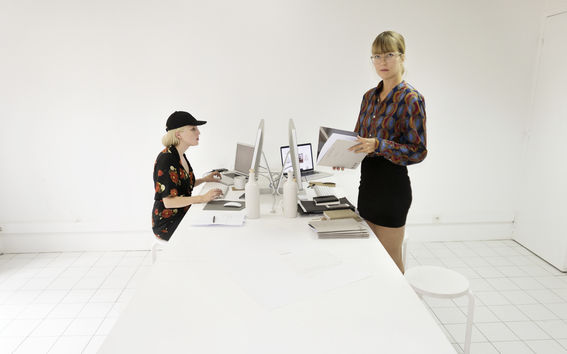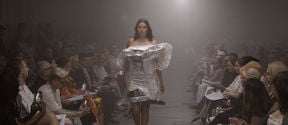A marriage of sorts

The beginning was as sudden as a lightning strike.
In the spring of 2006, graphic designers Anna Ahonen and Katariina Lamberg were sitting on the lawn of Place des Vosges in Paris bouncing ideas for a Parisian women's clothing label off one another. The pair knew each other from the university and moved in the same Paris circles, but this was the first time they were working together. There has been no turning back since then.
“The train of thought, the synergy and flow. There was something very invigorating in it all,” says Ahonen with Lamberg smiling and nodding at her side.
Now, a decade later, the duo have their own design studio in the 11th arrondissement of Paris that has designed, among other things, a new visual identity for the Turo clothing label, print designs for Adidas, Diesel and Lacoste, the typography used in Wallpaper magazine's cover and headlines as well as the floral print in which the entire Printemps department store was wrapped in to mark the 150th anniversary of this Paris landmark. Ahonen & Lamberg were named Finland's best graphic designers of the year 2014.
Running a studio in Paris sounds like a dream job, but the road to becoming a successful business contains many ups and downs.
“Thankfully, we did not anticipate all of what's required to run a business. We took a leap in the dark out of sheer enthusiasm to be working together,” Lamberg says.
Cheques and collection letters
Anna Ahonen and Katariina Lamberg originally came to Paris as part of a student exchange. Lamberg first worked as a senior designer for fashion magazine Self Service and Ahonen as a freelancer. Both have never looked back.
Once their first work as a duo was completed, the grapevine was abuzz with good references. International clients were already knocking on the door when Lamberg handed in her notice and established a company with Ahonen in autumn 2006. At first, French bureaucracy felt too daunting and they registered a business in Finland.
Working from Finland to France was not entirely uncomplicated, though.
“We were considered wage earners and employees of a Finnish company in France. This meant that social security and pension payments had to go via Strasbourg at great expense,” Lamberg says.
VAT was also problematic, as the case involved a Finnish company engaging in international work in France.
“No one had advice for us in Finland,” Ahonen recalls.
A couple of years later, an acquaintance directed them to a good Parisian bookkeeper who was able to convince the duo that the French system had some benefits as well. Design studio Ahonen & Lamberg turned into a French company.
“In France, companies of this size do not distribute dividends. We hold equal shares in the company and work under the title of gérant, or business manager. We receive ‘manager compensation’, which means that we pay ourselves a salary on which we pay personal income tax,” Lamberg explains.
There are also differences in national accounting practices and the recognition of expenses, in addition to which France's slow-moving bureaucracy took some getting used to.
“In Finland, entrepreneurs can take care of pretty much everything online, while in France you often post letters in the mail. And cheques as well,” Ahonen says.
Experience has shown that cheques can be convenient as well. There's no need to worry about digging up some cash when a courier stops by the bureau, for example.
But the biggest difference between Finland and France involves terms of payment. In Finland, invoices are settled within two weeks, while in France you have to wait for three months or more.
“In the early days, we'd often have to wait six months to get paid. The big companies are the worst. We still haven't received all of our money from one mid-sized French fashion house,” Lamberg says.
Accordingly, debt collection has become a regular activity for them.
“Clients often elegantly respond that the cheque must have been lost in the mail.”
Balancing creative work and business
Fortitude, critique and confidence in your own work. A financial plan and an action plan. The ability to take risks and a realistic vision. Common desires and goals.
Ahonen and Lamberg list key aspects of entrepreneurship as if reading from the same page.
Lamberg says that it immediately becomes apparent if the foundation and values are not properly aligned in a typical project, such as designing a visual appearance for an early-stage company. If the client's objectives, schedule and expected return are unclear, the pair's work can feel like just tinkering with the surface.
This is something they have not had to worry about privately. Their cooperation has always flowed naturally, nearing symbiosis at times. Lamberg handles money, bookkeeping and payroll issues, while Ahonen is the diplomat who'll talk about the company's feelings. The project lead will be taken on by whoever has time to respond to a client first or whoever has the best rapport with him or her.
“I love Excel spreadsheets and have a compulsion to impose order on things,” Lamberg laughs.
“We arrange palavers and talk about where we want to be in five or ten years time. Entrepreneurs can't go totally hippy,” Ahonen continues.
But their work is more than just a business.
Out of the business bubble
Four years ago, turnover had grown and this had boosted their confidence. Ahonen and Lamberg sat down and carefully raised the subject of where they were heading.
They realised they had transformed from artists and graphic designers into entrepreneurs, been plunged into the business bubble and were now only talking about productivity. They realised capitalist growth and the hiring of more and more people did not have to be their objective. Other values were more important.
One of these is work itself. The pair engage in many different kinds of projects at the same time and love to learn new things. Lamberg's subjective guidebook to Paris, Sacré-Cœur, was published last autumn and the two are now working on a visual identity for a new Parisian clothing label as well as for a furniture design bureau in Finland. A 10-year jubilee publication of their work is also in the pipeline. They have exhibited in Tokyo, New York and Helsinki, and the two have also found the time to teach at an art university in Germany.
The duo is also involved in the production side of their projects.
“When we designed the paintings circling the walls of the 400-square-metre London flagship store of Canadian shoe firm Aldo, we selected the technique, engaged a firm to paint the pictures on the walls by hand and checked that the painted squares were of the right colour and as straight or askew as specified,” Ahonen says.
The style of Ahonen & Lamberg is known for its taming of restless elements, as if arranging a type of chaos into a graphic form.
“The basic starting point of our design is classical, to which we introduce an innovation, a fissure or chink. If we have to think about it two, three or four times, then the client and their customers will surely pay attention to it twenty times. That's what good design is like,” Lamberg says.
Together through thick and thin
Our Finnish duo nearly spurted out their caviare-laden futomaki when a Japanese client expressed surprise on learning that they two were not a couple at a sushi dinner in Tokyo six years ago.
“Well, running a business is like a marriage of sorts,” Ahonen says and laughs.
“Anna and I are like a married couple who don't have sex. We answer to each other financially and regarding our time use, and we share almost everything,” Lamberg continues.
Through their work, the two women have grown not only into business partners, but also into close friends who know each other's good and bad sides. After all these years, the two remain confident that together they'll make it through thick and thin.
“Sharing responsibility and having an emotional safety net is important. We've both grown over the last decade – and not always in the same direction – yet everything still feels meaningful,” Ahonen says.
They think the best part of being an entrepreneur is the freedom. You can do things you like doing. Or leave work for an early aperitif or to pick up the kids for daycare when you want to.
“If you're a woman and want to have children, you just have to stop worrying and have them. Anna held the company afloat during my maternity leave four years ago and I did the same this year when Anna had her first child,” Lamberg says.
Before they had kids, the two used to come to work around eleven. Now, they might be there by nine. This is early by Parisian standards.
“We always break for lunch because that's when we get to be friends and talk about life. Sometimes we'll finish talking shop over an after-work drink,” Ahonen says.
The design duo recall learning the fundamentals of the aperitif in Helsinki's Kipsari bar during their student days. The network formed in those years still remains strong.
“Back then, we used self-reflection and uncompromising analysis to discover our own thing, which we devoted ourselves to 100 percent. This is one key to becoming a successful entrepreneur,” Lamberg says.
“We learned that it was fun to do things ourselves,” Ahonen says.
“That will always come before entrepreneurship.”
- Katariina Lamberg (on the left in the picture), 38, was born in Helsinki. She studied literature at the University of Helsinki as well as graphic design at the University of Art and Design Helsinki and ESAG Penninghen in Paris. She worked as a senior designer at fashion magazine Self Service before their own company. Lives in Montmartre with her husband and 4½-year-old son. Her hobbies include yoga, Pilates, literature, gardening and brewing kombucha.
- Anna Ahonen, 35, comes from Hyvinkää. She studied graphic design at the University of Art and Design Helsinki and the ENSAD in Paris. Worked as a freelance designer before their own company. Lives in the 9th arrondissement together with her boyfriend and their 8-month-old daughter. Her spare time is spent on yoga, boating, road trips and attending cultural events.
Text: Pihla Hintikka. Photo: Grégory Kowalski
The article is originally published in Finnish in Aalto University Magazine 17 (issuu.com), October 2016.
Read more news

Anastasia Koptsyukh and Ewald Kibler have been awarded Best Paper Award 2023 BCERC
They have been awarded the Best Paper in Social Entrepreneurship by the MEANS Center for Entrepreneurship Studies of Illinois State University and Babson College
Reetta Ranta: ‘I try to think about how to make the world a better place’
Alum story: Alum of the School of Arts, Design and Architecture believes that everything we do should involve ethical reflection.
Call for applications: Aalto University’s next creative industry pre-incubator programme starts in October 2024
The application period for the Aalto Digital Creatives pre-incubator program is open until 16.9.20234